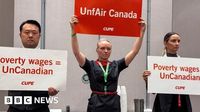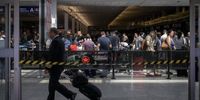Air Canada, the country’s largest airline, has been brought to a standstill as more than 10,000 of its flight attendants walked off the job early Saturday morning, August 16, 2025, plunging the travel plans of hundreds of thousands of passengers into chaos. The strike, which began just before 1 a.m. Eastern Time, is the first by Air Canada flight attendants since 1985 and comes after months of tense contract negotiations failed to yield a deal. The industrial action, set to last at least 72 hours, has forced the airline to suspend all flights under both its main brand and its budget arm, Air Canada Rouge, affecting an estimated 130,000 customers each day.
The Canadian Union of Public Employees (CUPE), which represents the flight attendants, confirmed the start of the strike in a social media post, marking the culmination of more than eight months of negotiations. According to Reuters, the union’s core demands include higher salaries and, crucially, compensation for work performed while the aircraft is on the ground—such as boarding passengers and preparing the cabin—tasks for which attendants are currently unpaid. "When we stood strong together, Air Canada didn’t come to the table in good faith. Instead, they called on the federal government to step in and take those rights away," the union stated in a message to its members.
Air Canada, for its part, said it had already offered a 38% increase in total compensation over four years, including a 25% raise in the first year. The company described the strike as deeply regrettable. "Air Canada deeply regrets the effect the strike is having on customers," the airline said in a statement, as cited by the BBC. However, CUPE dismissed the offer as “below inflation, below market value, below minimum wage,” insisting that it would still leave flight attendants unpaid for several hours of work each day.
The impact of the strike has been immediate and sweeping. By Friday night, August 15, Air Canada had already canceled 623 flights in anticipation of the labor action, disrupting the plans of more than 100,000 passengers ahead of the busy weekend. As the strike took effect, the airline strongly advised customers not to go to the airport unless they had a confirmed ticket on another carrier. Regional operators like Air Canada Jazz and PAL Airlines have continued to operate, but the vast majority of the airline’s network—spanning direct flights to 180 cities worldwide—has been grounded.
At major airports across Canada, scenes of confusion and frustration played out as stranded passengers scrambled to secure alternative travel arrangements. At Toronto Pearson International Airport, passengers like Freddy Ramos, 24, experienced repeated delays and cancellations. "Probably 10 minutes prior to boarding, our gate got changed and then it was canceled and then it was delayed and then it was canceled again," Ramos told Reuters. Many travelers have taken to social media to express solidarity with the flight attendants, even as they voiced frustration over the disruption to their summer plans.
Behind the scenes, the labor dispute has sparked a broader debate about the rights and compensation of airline workers. Flight attendants argue that being paid only when the plane is moving—commonly referred to as “block time”—ignores the substantial work they perform before takeoff and after landing. The union’s push to secure pay for these hours has resonated with other labor groups and with segments of the public who see the issue as a matter of fairness and respect for essential workers.
Businesses, however, have voiced mounting concern over the economic fallout. Canadian companies, already grappling with a trade dispute with the United States, have urged the federal government to impose binding arbitration to bring the strike to an end. According to Reuters, Air Canada has formally requested that Prime Minister Mark Carney’s government intervene by referring the dispute to binding arbitration, a move permitted under the Canada Labour Code. The country’s jobs minister, Patty Hajdu, has so far resisted calls for immediate intervention, instead urging both sides to return to the bargaining table. "I urge Air Canada and the union to keep talking and find a solution that works for everyone," Hajdu said in a statement earlier this week.
The union, however, has made it clear that it opposes government-imposed arbitration, seeing it as a threat to workers’ rights to collective bargaining. CUPE insists it has negotiated in good faith and accuses Air Canada of trying to sidestep direct talks by appealing for government intervention. The standoff has raised questions about the balance between protecting the economy and respecting workers’ rights in Canada’s heavily regulated airline industry.
Financial analysts have also weighed in, warning of the risks the dispute poses to Air Canada’s bottom line. In a note to clients, TD Cowen analysts cautioned that the company’s refusal to make further concessions could backfire. "Not budging on negotiations risks being a Pyrrhic victory," the note stated, suggesting that the costs of lost revenue and reputational damage could outweigh any savings on labor expenses during the airline’s most important quarter.
The strike’s timing couldn’t be worse for Air Canada. The summer travel season is typically the busiest and most profitable period for the airline, which is also the largest foreign carrier servicing the United States by number of scheduled flights. With operations suspended, the airline has warned that even if an agreement is reached soon, it will take at least a week to return to full operations. That means the disruption could stretch well beyond the formal end of the strike, leaving travelers and the broader industry in limbo.
As picket lines formed outside major Canadian airports, the dispute also highlighted the growing assertiveness of organized labor in North America. Earlier this month, 99.7% of Air Canada flight attendants represented by CUPE voted in favor of striking, underscoring the depth of frustration among rank-and-file workers. The union’s willingness to walk out in the face of government and corporate pressure signals a broader trend of labor activism, as workers across industries push for better pay and conditions in a post-pandemic landscape.
For now, the standoff shows no sign of immediate resolution. Air Canada’s offer remains on the table, but the union appears determined to hold out for a better deal. Passengers, meanwhile, are left to navigate the uncertainty, rebooking flights where possible and hoping for a swift end to the dispute. As the days tick by, the pressure mounts on both sides to find common ground—or risk further alienating the traveling public and deepening the economic toll.
One thing is certain: the outcome of this high-stakes showdown will shape not only the future of Air Canada’s workforce but also set a precedent for labor relations in the airline industry for years to come.

